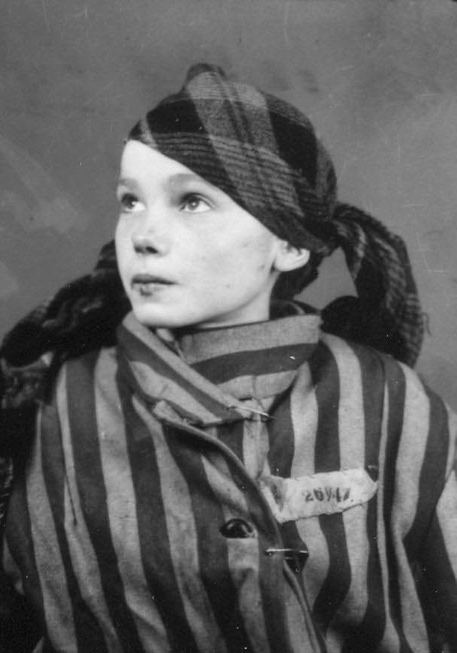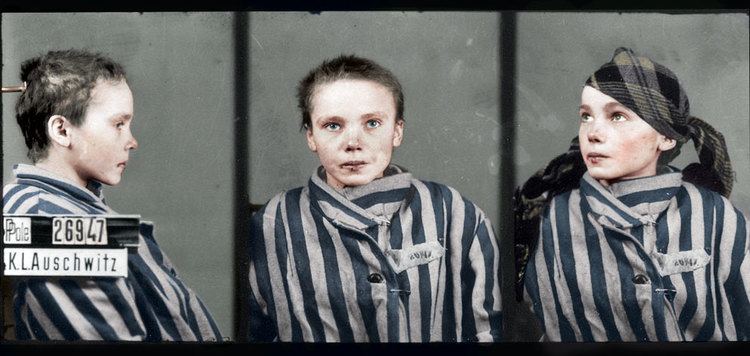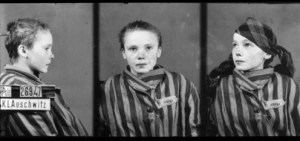Cause of death uncertain Religion Catholic Name Czeslawa Kwoka | Parent(s) Katarzyna Kwoka | |
 | ||
Known for being one of thousands of victims of German World War II crimes against Poles whose "identity pictures" Wilhelm Brasse was ordered to take at Auschwitz; memorialized in the Auschwitz-Birkenau State Museum exhibition in Block no. 6 (1955–); being shown in the documentary film The Portraitist (2005); and inspiring creation of Painting Czeslawa Kwoka (2007) | ||
Czes awa kwoka
Czesława Kwoka (15 August 1928 Wólka Złojecka – 12 March 1943 Auschwitz) was a Polish Catholic child who died in the Auschwitz concentration camp at the age of 14. She was one of the thousands of child victims of German World War II crimes against Poles. She died at Auschwitz-Birkenau in German-occupied Poland, and is among those memorialized in the Auschwitz-Birkenau State Museum indoor exhibit called 'Block no. 6: Exhibition: The Life of the Prisoners.'
Contents
- Czes awa kwoka
- Auschwitz german camp czes awa kwoka26947
- Personal background
- General historical contexts of child victims of Auschwitz
- Particular historical contexts of photographs of Czesawa Kwoka
- Auschwitz Identification photographs in memorial exhibits and photo archives
- Brasses memories of photographing Kwoka
- Commemoration in art Painting Czesawa Kwoka
- References
Photographs of Kwoka and others taken by the "famous photographer of Auschwitz", Wilhelm Brasse, from 1940 to 1945, displayed in that Museum photographic memorial, several of which Brasse holds up and discusses in The Portraitist, a 2005 television documentary film about Brasse, became a focus of interviews with Brasse cited in various articles and books.

Brasse's three photographs of Kwoka in particular inspired the creation of Painting Czesława Kwoka (2007), a literary award-winning collaborative work of art and verse which attempts to transport her "image and voice into our lives."

Auschwitz german camp czes awa kwoka26947
Personal background

Czesława Kwoka was born in Wólka Złojecka, a small village in Poland, to a Catholic mother, Katarzyna Kwoka. Along with her mother (prisoner number 26946), Czesława Kwoka (prisoner number 26947) was deported and transported from Zamość, Poland, to Auschwitz, on 13 December 1942. On 12 March 1943, less than a month after her mother died (18 February 1943), Czesława Kwoka died at the age of 14; the circumstances of her death were not recorded.
General historical contexts of child victims of Auschwitz

Czesława Kwoka was one of the "approximately 230,000 children and young people aged less than eighteen" among the 1,300,000 people who were deported to Auschwitz-Birkenau from 1940 to 1945.

The Auschwitz-Birkenau State Museum's Centre for Education About the Holocaust and Auschwitz documents the wartime circumstances that brought children like Kwoka and young adults to the concentration camps in its 2004 press release announcing the publication of an album of photographs of some of them, many years in development, compiled by its historian Helena Kubica; these photographs were first published in the Polish/German version of Kubica's book in 2002. According to the Museum's press release, of the approximately 230,000 children and young people deported to Auschwitz, more than 216,000 children, the majority, were of Jewish descent; more than 11,000 children came from Romani (Roma) families; the other children had Polish, Belarusian, Ukrainian, Russian, or other ethnic backgrounds.

Most of these children "arrived in the camp along with their families as part of the various operations that the Nazis carried out against whole ethnic or social groups"; these operations targeted "the Jews as part of the drive for the total extermination of the Jewish people, the Gypsies as part of the effort to isolate and destroy the Gypsy population, the Poles in connection with the expulsion and deportation to the camp of whole families from the Zamość region and from Warsaw during the Uprising there in August 1944", as well as Belarusians and other citizens of the Soviet Union "in reprisal for partisan resistance" in places occupied by Germany.
Of all these children and young people, "Only slightly more than 20,000 ... including 11,000 Gypsies, were entered in the camp records. No more than 650 of them survived until liberation [in 1945]."
Czesława Kwoka was one of those thousands of children who did not survive Auschwitz and among those whose "identity photographs", along with captions constructed from the so-called Death Books, are featured in a memorial display on a wall in Block no. 6: Exhibition: Life of the Prisoners.
Particular historical contexts of photographs of Czesława Kwoka
After her arrival at Auschwitz, Czesława Kwoka was photographed for the Reich's concentration camp records, and she has been identified as one of the approximately 40,000 to 50,000 subjects of such "identity pictures" taken under duress at Auschwitz-Birkenau by Wilhelm Brasse, a young Polish inmate in his twenties (known as Auschwitz prisoner number 3444). Trained as a portrait photographer at his aunt's studio prior to the 1939 German invasion of Poland beginning World War II, Brasse and others had been ordered to photograph inmates by their Nazi captors, under dreadful camp conditions and likely imminent death if the photographers refused to comply.
These photographs that he and others were ordered to take capture each inmate "in three poses: from the front and from each side." Though ordered to destroy all photographs and their negatives, Brasse became famous after the war for having helped to rescue some of them from oblivion.
Such acts of courage as Brasse's and his colleagues enabled many like Kwoka not to become forgotten as mere bureaucratic statistics, but to be remembered as individual human beings.
Auschwitz "Identification photographs" in memorial exhibits and photo archives
While most of these photographs of Auschwitz inmates (both victims and survivors) are not extant, some photographs do populate memorial displays at the Auschwitz-Birkenau State Museum, where the photographs of Kwoka reside, and at Yad Vashem, the Holocaust Martyrs' and Heroes' Remembrance Authority, Israel's official memorial to the Jewish victims of the Shoah.
Captions attached to the photographs in the Auschwitz-Birkenau State Museum photo archives and memorial indoor exhibits have been constructed by the Museum Exhibition Department from camp registries and other records confiscated when the camps were liberated in 1945 and archived subsequently. These Museum photo archive captions attached to photographs assembled and/or developed from photographs and negatives rescued by Brasse and fellow inmate darkroom worker Bronislaw Jureczek during 1940 to 1945 identify the inmate by name, concentration-camp prisoner number, date and place of birth, date of death and age at death (if applicable), national or ethnic identity, religious affiliation, and date of arrival in the camp. Some photographs credited to Brasse, including the "identity picture" with 3 poses of Kwoka, are in the Auschwitz-Birkenau State Museum's photographic memorial to prisoners who did not survive Auschwitz, part of a permanent indoor exhibit called Block no. 6: Exhibition: The Life of the Prisoners, first mounted in 1955, and featured in a photograph taken by its Exhibition Department photographer on its official Website (©1999-2008), in some of the Museum's photographs in albums and catalogues that it published in 2000 and later by Kubica and others, and in the 2005 Polish television documentary film about Brasse, The Portraitist, shown on TVP1 and in film festivals, beginning in 2006. All visitors to the Museum are asked explicitly to respect the Site of the Death Camp and not to use cameras (both still and video) in its indoor exhibits.
The photo mural including Kwoka's "identity pictures" ("identification photographs" or "mug shots") displayed on a wall in the Auschwitz-Birkenau State Museum's permanent indoor exhibition The Life of the Prisoners in Block no. 6 is captured in Ryszard Domasik's photograph cropped (without the photographs of Kwoka) featured on its official Website.
Brasse's memories of photographing Kwoka
Brasse recalls his experience photographing Kwoka specifically in The Portraitist, an account corroborated by BBC correspondent Fergal Keane who interviewed Brasse about his memories of taking them, in a Live Mag feature article "Returning to Auschwitz: Photographs from Hell", occasioned by the film's London premiere (22 April 2007), published in the Mail Online on 7 April, which does not include illustrations of these photographs of Kwoka.
As a visitor to the Auschwitz-Birkenau State Museum memorial exhibit in Block no. 6, Keane also describes his own impressions of the photographs of Kwoka in some detail.
For days after viewing the photographs, I could not shake the girl's expression from my mind. She is around 16 [sic] years of age and looking directly into the camera.
The girl has only recently arrived at the camp. On her lower lip there is a cut. Her eyes stare directly into the lens and the fear transmits itself across the decades.
But until Wilhelm Brasse told me his extraordinary story I had no idea how the photograph came to be taken. His voice trembles as he recounts what happened.
She was so young and so terrified. The girl didn't understand why she was there and she couldn't understand what was being said to her.
So this woman Kapo (a prisoner overseer) took a stick and beat her about the face. This German woman was just taking out her anger on the girl. Such a beautiful young girl, so innocent. She cried but she could do nothing.
Before the photograph was taken, the girl dried her tears and the blood from the cut on her lip. To tell you the truth, I felt as if I was being hit myself but I couldn't interfere. It would have been fatal for me. You could never say anything.
Commemoration in art: Painting Czesława Kwoka
"Bring[ing] Czeslawa's image and voice into our lives", Theresa Edwards (verse) and Lori Schreiner (art) created Painting Czesława Kwoka, a collaborative work of mixed media inspired by the three photographs of Kwoka taken by Wilhelm Brasse in 1942 or 1943.
Displayed at the Windham Art Gallery in Brattleboro, Vermont, from 1 June to 1 July 2007 as part of the exhibition Words & Images: A Collaboration, Painting Czesława Kwoka further commemorates Kwoka and all child victims of the Holocaust, as well as others who lost their lives as a result of war.
It received the 2007 Tacenda Literary Award for Best Collaboration, presented by BleakHouse Publishing.
